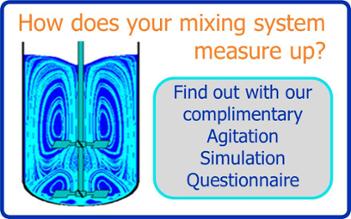Optimizing your Mixing System: A Compilation of Posts
 If your reactor isn’t operating at the productivity rate it used to, there are a number of reasons that could be causing this. It depends on the symptoms, but usually one of the first items you should look at is the mixing system. After all, agitation is a primary part of the reaction process and it is one of the technologies that can be tweaked or upgraded to help optimize the performance of the entire operation.
If your reactor isn’t operating at the productivity rate it used to, there are a number of reasons that could be causing this. It depends on the symptoms, but usually one of the first items you should look at is the mixing system. After all, agitation is a primary part of the reaction process and it is one of the technologies that can be tweaked or upgraded to help optimize the performance of the entire operation.
A mixing system is more than just the agitator itself – agitator blades, baffles, mechanical seals, drives, as well as operating procedures (blade angle, rpm, number of tiers, etc.) are all factors that work together to create a one-of-a-kind mixing environment. Add in product characteristics, temperature and other process specifications and you have yourself a complex list of options. Small changes to any of these factors can have a big impact on your application so it’s important to take everything into account when establishing or reconstructing the parameters of your process.
Here are some questions to ask yourself when you are considering how you can improve your mixing:
1. Are you following the rules of “Mixing 101”?
It’s important to be following the right mixing guidelines when your vessel is being filled and emptied. Fluid level in relation to agitator blade level is also something that needs to be monitored. Our post on agitation best practices for improved mixing covers all of this and more.
2. Is your mechanical seal in good condition? Are you using the best type of seal for your drive system?
There are a few different options for agitator seals on a glass-lined reactor and different scenarios when it might be advantageous to use one over another. More information about dry-running, wet seals, and OptiSeal (DDPS’ new standard model) are available in the link referenced above. If you are having issues with your seal, this two part post offers advice for how to troubleshoot and correct the improper performance of mechanical seals.
3. Are you using components that are the most suitable for carrying out your process objectives?
A lot of the time standard baffles and agitators can offer the versatility needed to perform a number of different mixing objectives. You may find, however if you have a viscous product, issues with fragility, or in general are looking for better than average mixing, upgrades are available to enhance the performance of your reactor. Our posts about baffle options and agitator options for glass-lined reactors will inform you more about your options concerning these parts.
4. Have you done a comparison to see how other mixing parameters would affect your process?
Agitation simulations are a great way to get a virtual comparison of your current system with several alternative systems to get customized advice about your process can be improved. This includes but is not limited to optimization for suspension, dissolution, extraction, dispersion, and emulsion. The insight provided by the software used in these simulations is extremely beneficial in determining what changes you should make to your current system, from minor tweaks in operation to a complete overhaul using new, upgraded components.
De Dietrich Process Systems can help out with any technical support or process advice related to mixing systems. If you feel that your reactor could be performing better, it’s a good idea to start by looking at the components that make up your mixing system and look into how it can be improved. Contact us or click on the link below to fill out an Agitation Simulation Questionnaire. This could be the first step towards new, improved mixing for your glass-lined reactor.
